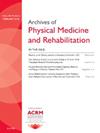Restoration of Upper-extremity Function After Intention-driven Functional Electrical Stimulation Using a Wearable Sleeve in 2 Adults with Chronic Stroke: A Case Series 4352
IF 3.6
2区 医学
Q1 REHABILITATION
Archives of physical medicine and rehabilitation
Pub Date : 2025-04-01
DOI:10.1016/j.apmr.2025.01.038
引用次数: 0
Abstract
Objectives
To investigate the feasibility of using a wearable, high-density electrode sleeve to provide intention-driven functional electrical stimulation (FES) therapy, and to evaluate the preliminary effects on recovery in 2 adult chronic stroke survivors.
Design
During the 8-week intervention period, therapy was administered using the intention-driven FES sleeve during three 2-hour sessions. After the 8-week intervention period, subjects were monitored in a 10-week follow-up period during which task-oriented training was not administered. However, FES was delivered during this period to enable continued engineering development of the sleeve.
Setting
This study was performed at Battelle Memorial Institute..
Participants
This study enrolled adults with upper limb hemiparesis, stroke-related hand impairment that interferes with the ability to complete activities of daily life, and who were classified as stage 1-6 on the hand subscale of the Chedoke McMaster Stroke assessment. Individuals actively participating in stroke-related upper limb rehabilitation, co-occurring neurological or neuromuscular conditions, or implanted electronic devices were excluded.
Interventions
The intervention was comprised of using an investigational device composed of a high-density grid of electrodes embedded in a sleeve to deliver FES during therapist (occupational therapist)-guided therapy. FES was delivered either (1) by an operator that matched FES to the subject's intention, or (2) by the wearer's own electromyographic signals. The operator-controlled FES system was used twice per week, and the electromyographic-controlled FES system used once per week. At each session, the occupational therapist chose functional tasks, graded them to an appropriate difficulty, and administered practice for approximately 20 minutes before moving on to a new task.
Main Outcome Measures
Main outcome measures include the Action Research Arm Test, the Fugl-Meyer Assessment Upper Extremity, and the Box and Blocks test.
Results
At the conclusion of the 8-week therapy schedule, both subjects demonstrated improvements that exceeded the minimal clinically important difference on the Action Research Arm Test, Fugl-Meyer Assessment Upper Extremity, and the Box and Blocks test. These improvements were sustained during the 10-week follow-up period.
Conclusions
These results provide an initial, preliminary demonstration in 2 stroke survivors of using intention-driven FES therapy incorporating multiple FES-enabled movements using a wearable forearm sleeve. Larger studies are needed to validate these findings. This device has not been approved or cleared as safe or effective by US Food and Drug Administration. This device is limited by US federal law to investigational use.
Disclosures
All authors are employees of Battelle Memorial Institute, which has developed the described NeuroLife Sleeve.
求助全文
约1分钟内获得全文
求助全文
来源期刊
CiteScore
6.20
自引率
4.70%
发文量
495
审稿时长
38 days
期刊介绍:
The Archives of Physical Medicine and Rehabilitation publishes original, peer-reviewed research and clinical reports on important trends and developments in physical medicine and rehabilitation and related fields. This international journal brings researchers and clinicians authoritative information on the therapeutic utilization of physical, behavioral and pharmaceutical agents in providing comprehensive care for individuals with chronic illness and disabilities.
Archives began publication in 1920, publishes monthly, and is the official journal of the American Congress of Rehabilitation Medicine. Its papers are cited more often than any other rehabilitation journal.

 求助内容:
求助内容: 应助结果提醒方式:
应助结果提醒方式:


